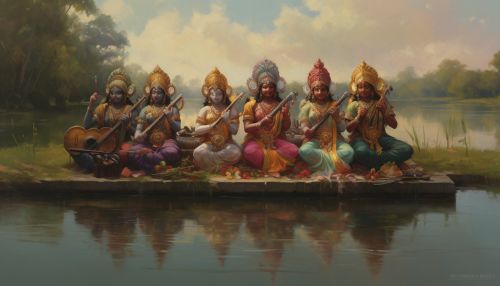Hindu deities
Overview
Hindu deities are the gods and goddesses in Hinduism. The terms and concepts for deity within the diverse traditions of Hinduism vary, and include Deva, Devi, Ishvara, Bhagavān and Bhagavati. The deities of Hinduism have evolved from the Vedic era (2nd millennium BC) through the medieval era (1st millennium AD), regionally within Nepal, India and in southeast Asia, and across Hinduism's diverse traditions. The Hindu deity concept varies from a personal god as in Yoga school of Hindu philosophy, to 33 Vedic deities, to hundreds of Puranics of Hinduism. Illustrations of major deities include Vishnu, Sri (Lakshmi), Shiva, Sati, Brahma and Saraswati. These deities have distinct and complex personalities, yet are often viewed as aspects of the same Ultimate Reality called Brahman.


Historical Development
The concept of Hindu deities evolved over time. The earliest Hindu scriptures, the Vedas, introduced the pantheon of Vedic deities. This pantheon was significantly expanded and modified in the Puranas, which were composed much later. The Puranas introduced many deities who are less known today but were once prominent in regional traditions of Hinduism.
Vedic Deities
The Vedas, the oldest scriptures of Hinduism, contain hymns to various deities. The Rigveda, the oldest of the Vedas, contains hymns primarily to Agni (the fire god), Indra (the king of gods), and Varuna (the guardian of the cosmic order). The Yajurveda contains hymns to a wider range of deities, including the wind-god Vayu and the death-god Yama. The Samaveda, a collection of chants, contains hymns to Soma (the plant god) and Rudra (the storm god, later identified with Shiva). The Atharvaveda, a collection of spells and charms, contains hymns to a variety of deities, including Prithvi (the earth goddess) and Ushas (the dawn goddess).
Puranic Deities
The Puranas, composed between 300 and 1500 CE, contain narratives about the creation of the universe, genealogies of gods, legends of saints and sages, and tales of devotional deeds. These texts introduced many new deities and elaborated on the myths and legends associated with older deities. The Puranas also introduced the concept of the Hindu trinity or Trimurti, consisting of Brahma (the creator), Vishnu (the preserver), and Shiva (the destroyer).
Major Deities
Among the many Hindu deities, a few are more widely worshipped and have larger bodies of mythology and theology associated with them. These include Vishnu, Shiva, Devi (the Goddess, who is worshipped in various forms, such as Durga, Kali, and Lakshmi), Ganesha, Hanuman, and Surya.
Worship and Rituals
Hindu deities are worshipped through a variety of rituals, which may vary greatly among different communities and regions. These rituals include daily prayers (puja), recitation of sacred texts, performance of sacrifices (yajna), processions, and festivals. Many Hindus also undertake pilgrimages to temples and other sacred sites associated with their chosen deity.
Iconography
The iconography of Hindu deities is rich and varied. Deities are typically depicted with multiple arms, which symbolize their divine powers. They may hold various objects, such as weapons or symbols of their functions, and are often shown riding on vahanas (animal mounts). Deities are also associated with specific colors, which have symbolic meanings.
Philosophy and Theology
The philosophical and theological aspects of Hindu deities are complex and varied. Some schools of Hindu philosophy, such as Advaita Vedanta, view the deities as manifestations of a single, impersonal Absolute Reality or Brahman. Other schools, such as Dvaita Vedanta, see a distinction between individual souls and the Supreme Being, and view worship of deities as a means to attain liberation (moksha).
